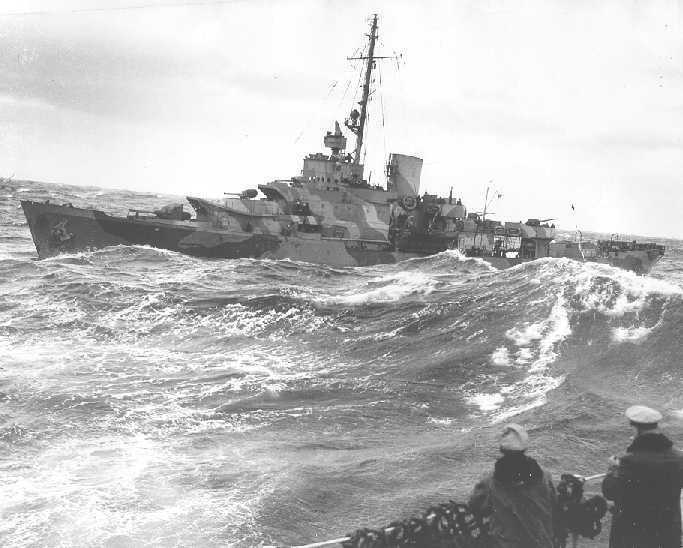
Welcome to MSW’s Scuttlebutt! Here’s the news for the day.
Feature - Type II A German U-boat
New MSW Crew member Jacob Hederstierna-Johnse shares with us his build of the Type II A German U-boat.

San Diego (LPD 22) Returns from Successful Builder's Sea Trials
Source: Huntington Ingalls Industries, Inc.
PASCAGOULA, Miss. --- Huntington Ingalls Industries, Inc. announced that the company's sixth amphibious transport dock, San Diego (LPD 22), returned over the weekend from successful builder's sea trials in the Gulf of Mexico. The ship is currently under construction at Ingalls Shipbuilding.
"This is one of the best and most successful trials I've been on aboard an LPD ship," said Doug Lounsberry, Ingalls' vice president and program manager, LPD 17 Program. "Everybody came together and worked hard to make this a great builder's trials, and I have been impressed with the dedication of our shipbuilders to get San Diego ready for this event. It takes four to five years to build one of these ships, and the men and women we have aboard this ship have invested a large part of their lives to seeing San Diego get to this point. I am very proud of each and every one of them for their hard work."
Ingalls' test and trials team thoroughly tested the ship's main propulsion, communications, steering and navigational radar systems, among others. More than 200 test events took place during the four-day sea trial, including anchor handling, flight operations, ballasting/de-ballasting the well deck and compartment air balancing.
"This builder's trial has gone very well," said Richard Schenk, Ingalls' vice president, test and trials. "It has given us an opportunity to test many of the systems on this ship--from combat to steering to propulsion--and this ship has performed extremely well. When our shipbuilders get the opportunity to see the fruits of their labor--not just the finished ship but also how well it performs on trials--they are clearly proud of what they have accomplished. This has been a joint effort between our shipbuilders and the United States Navy. Just like our men and women, the ship's crew has also shown a lot of pride in this ship and is very excited to see what their new home is all about."
The ship will now prepare for acceptance sea trials to demonstrate the same tests and seaworthiness to the U.S. Navy's Board of Inspection and Survey (INSURV). The ship is scheduled to be delivered to the Navy by the end of 2011.
The LPD 17-class ships are a key element of the Navy's ability to project power ashore. Collectively they functionally replace more than 41 ships (the LPD 4, LSD 36, LKA 113 and LST 1179 classes of amphibious ships), providing the Navy and Marine Corps with modern, sea-based platforms that are networked, survivable and built to operate with 21st century platforms, such as the MV-22 Osprey.
The San Antonio-class ships are 684 feet long and 105 feet wide and displace approximately 25,000 tons. Their principal mission is to deploy the combat and support elements of Marine Expeditionary Units and Brigades. The ships can carry up to 800 troops and have the capability of transporting and debarking air cushion (LCAC) or conventional landing crafts, augmented by helicopters or vertical take-off and landing aircraft such as the MV-22. These ships will support amphibious assault, special operations or expeditionary warfare missions through the first half of the 21st century.
Warship Destroys Lethal Underwater Bombs
Source: British Forces Broadcasting Service
British warship HMS Bangor has destroyed two underwater bombs on NATO operations off Libya.
After exploding a 1,000-kilogramme mine on the sea bed near the key port of Tobruk using a Sea Fox drone, the minehunter also found a torpedo that also had to be destroyed.
HMS Bangor’s skipper, Lieutenant Commander Neil Marriott, said: “To find two pieces of ordnance and destroy them safely is a great result for my ship’s company. We have been hunting for mines since June, working from port to port, and a success like this means shipping into Libya is that much safer.”
Both weapons were spotted by a mine warfare team working in Bangor’s darkened operations room. They scan sonar screens which show shadows and shapes on the sea bed.
Ops room supervisor Petty Officer Steve ‘Stirling’ Moss said: “When we’re mine-hunting we have several people watching the screens for any contact.
“On this task we saw several items which looked about the size of a mine, and two of them turned out to be real.
“It’s not a regular thing to happen, so we’re really pleased we found them and we were able to destroy them.”
Bangor’s 38-strong crew have been part of Operation Unified Protector since taking over from the minehunter HMS Brocklesby, which blew up a mine near Misrata as the war.
She has now moved away from the Libyan coastline with a Dutch minehunter and Canadian frigate, but is ready to return if needed.

Torpedoing of the USS Kearny (DD 432)
Today is the anniversary of the Torpedoing of the USS Kearny (DD 432).

U-568
Today’s website is the U-568. Enjoy.
This Day in U.S. Naval History
1922 - Lt. Cmdr. Virgil C. Griffin, in a Vought VE-7SF makes first the takeoff from a U.S. Navy aircraft carrier, USS Langley (CV 1) anchored in York River, Va.
1941 - German U-boat U-568 torpedoes and damages USS Kearny (DD 432) near Iceland, resulting in 11 killed and 22 injured.
1944 - Naval Forces land Army Rangers on islands at the entrance to Leyte Gulf in preparation for landings.
1989 - Following the San Francisco earthquake, 24 Navy and Military Sealift Command ships render assistance.
Diorama Idea of the Day

One of the crack cutters of the Coast Guard, the Duane, runs into some foul weather in the North Atlantic. To see the original high resolution photo, click here.
Gator











